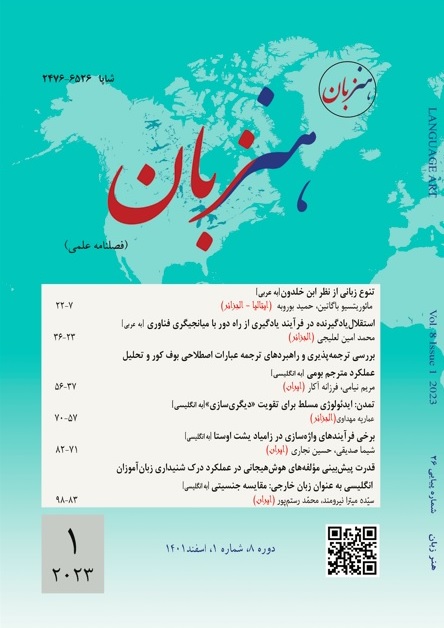بررسی ترجمهپذیری و راهبردهای ترجمه عبارات اصطلاحی بوف کور و تحلیل عملکرد مترجم بومی
DOI::
https://doi.org/10.22046/LA.2023.03کلمات کلیدی:
عبارات اصطلاحی, ترجمهپذیری, ترجمهناپذیری, مترجم بومی, عناصر فرهنگیچکیده
جهانی شدن ارتباطات بر اهمیت ترجمه افزوده است. با این حال، گاهی اوقات تفاوتهای فرهنگی و زبانی بین زبانها حتی بیشتر از نقش مترجم چالش برانگیز است. عبارات اصطلاحی اغلب مسائل چالش برانگیز در قلمرو ترجمه هستند. این پژوهش، به بررسی راهبردهای کاربردی و ترجمه پذیری عبارات اصطلاحی بوف کور پرداخته است. از این رو، ترجمه بشیری (1392) مورد بررسی قرار گرفت و دادهها برای یافتن راهبردهای کاربردی و بررسی ترجمهپذیری و ترجمهناپذیری عبارات اصطلاحی مورد تجزیه و تحلیل قرار گرفتند. دویست و نود عبارت اصطلاحی جمعآوری شد که تعدادی از آنها به دلیل تفاوتهای زبانی و فرهنگی غیرقابل ترجمه بودند. علاوه بر این، سبک نویسنده کتاب نیز بر ترجمه تأثیر گذاشته است. اگرچه عملکرد بشیری به عنوان مترجم بومی در به کارگیری راهبردهای ترجمه کارآمد بود، در برخی موارد، آشنایی وی با زبان و فرهنگ زبان مبدأ منجر به تطابق کامل بین متون مبدأ و مقصد نمیشود.
##submission.downloads##
چاپ شده
ارجاع به مقاله
شماره
نوع مقاله
مجوز
حق نشر 2023 Maryam Niami, Farzaneh Akar

این پروژه تحت مجوز بین المللی Creative Commons Attribution 4.0 می باشد.
فصلنامه هنر زبان یک مجله دسترسی آزاد است و مقالات پس از پذیرش در دسترس عموم قرار می گیرند و استفاده از آن با ذکر منبع آزاد است
